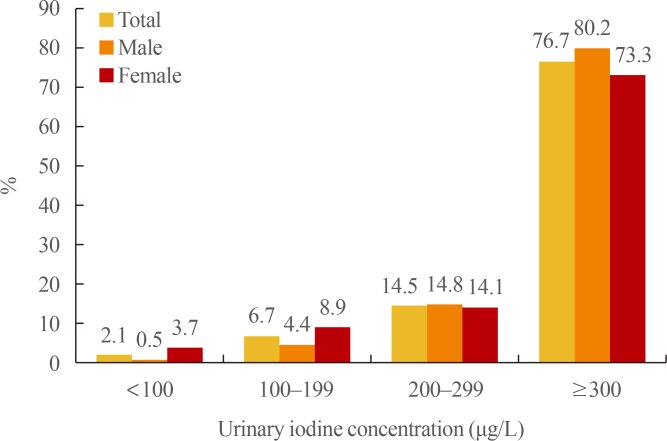Endocrinol Metab.
2017 Sep;32(3):370-374. 10.3803/EnM.2017.32.3.370.
Excessive Iodine Status among School-Age Children in Korea: A First Report
- Affiliations
-
- 1Department of Internal Medicine, Kosin University College of Medicine, Busan, Korea. 79kyung@hanmail.net
- 2Department Clinical Laboratory Science, Dong-Eui Institute of Technology, Busan, Korea.
- 3Department of Biochemistry, Kosin University College of Medicine, Busan, Korea. jyjeong@kosin.ac.kr
- 4Cancer Research Institute, Kosin University College of Medicine, Busan, Korea.
- KMID: 2389818
- DOI: http://doi.org/10.3803/EnM.2017.32.3.370
Abstract
- BACKGROUND
Korea is considered an iodine sufficient country, and several studies have been conducted regarding iodine status in healthy Korean adults, pregnant women, and preschool children. However, data on iodine status in Korean school-age children are lacking. Therefore, the iodine nutrition status of Korean school-age children was investigated by measuring urine iodine concentration (UIC).
METHODS
This cross-sectional study conducted between April and September 2016 comprised 373 school-age children. UIC was determined using a modified microplate method employing ammonium persulfate digestion followed by Sandell-Kolthoff reaction.
RESULTS
The median UIC was 458.2 µg/L. Excessive iodine intake (>300 µg/L) was found in 286 children (76.7%), with extremely high values exceeding 1,000 µg/L in 19.6% of subjects. Insufficient iodine intake (<100 µg/L) was observed in eight children (2.1%). UIC values were not significantly different between sexes.
CONCLUSION
Korean school-age children showed excessive iodine intake. Therefore, education regarding adequate iodine intake in school-age children is needed.
MeSH Terms
Figure
Cited by 1 articles
-
Effects of Maternal Iodine Status during Pregnancy and Lactation on Maternal Thyroid Function and Offspring Growth and Development: A Prospective Study Protocol for the Ideal Breast Milk Cohort
Young Ah Lee, Sun Wook Cho, Ho Kyung Sung, Kyungsik Kim, Young Shin Song, Sin Je Moon, Jung Won Oh, Dal Lae Ju, Sooyeon Choi, Sang Hoon Song, Gi Jeong Cheon, Young Joo Park, Choong Ho Shin, Sue K. Park, Jong Kwan Jun, June-Key Chung
Endocrinol Metab. 2018;33(3):395-402. doi: 10.3803/EnM.2018.33.3.395.
Reference
-
2. Du Y, Gao Y, Meng F, Liu S, Fan Z, Wu J, et al. Iodine deficiency and excess coexist in china and induce thyroid dysfunction and disease: a cross-sectional study. PLoS One. 2014; 9:e111937. PMID: 25375854.
Article3. Andersson M, Karumbunathan V, Zimmermann MB. Global iodine status in 2011 and trends over the past decade. J Nutr. 2012; 142:744–750. PMID: 22378324.
Article4. International Council for Control of Iodine Deficiency Disorders. UNICEF. World Health Organization. Assessment of iodine deficiency disorders and monitoring their elimination: a guide for programme managers. 3rd ed. Geneva: World Health Organization; 2007.5. Lee J, Kim JH, Lee SY, Lee JH. Iodine status in Korean preschool children as determined by urinary iodine excretion. Eur J Nutr. 2014; 53:683–688. PMID: 23881585.
Article6. Kim JY, Moon SJ, Kim KR, Sohn CY, Oh JJ. Dietary iodine intake and urinary iodine excretion in normal Korean adults. Yonsei Med J. 1998; 39:355–362. PMID: 9752802.
Article7. Cho YY, Kim HJ, Oh SY, Choi SJ, Lee SY, Joung JY, et al. Iodine status in healthy pregnant women in Korea: a first report. Eur J Nutr. 2016; 55:469–475. PMID: 25750059.
Article8. Sandell EB, Kolthoff IM. Micro determination of iodine by a catalytic method. Microchimica Acta. 1937; 1:9–25.
Article9. Wuethrich C, Jaeggi-Groisman SE, Gerber H. Comparison of two methods for the detection of urinary iodine used in epidemiological studies. Clin Chem Lab Med. 2000; 38:1027–1031. PMID: 11140618.
Article10. Centers for Disease Control and Prevention. Ensuring the quality of urinary iodine procedures. Atlanta: Centers for Disease Control and Prevention;2011.11. Pearce EN, Andersson M, Zimmermann MB. Global iodine nutrition: where do we stand in 2013? Thyroid. 2013; 23:523–528. PMID: 23472655.
Article12. Chung HR. Iodine and thyroid function. Ann Pediatr Endocrinol Metab. 2014; 19:8–12. PMID: 24926457.
Article13. Zava TT, Zava DT. Assessment of Japanese iodine intake based on seaweed consumption in Japan: a literature-based analysis. Thyroid Res. 2011; 4:14. PMID: 21975053.
Article14. Lewinski A, Szybinski Z, Bandurska-Stankiewicz E, Grzywa M, Karwowska A, Kinalska I, et al. Iodine-induced hyperthyroidism: an epidemiological survey several years after institution of iodine prophylaxis in Poland. J Endocrinol Invest. 2003; 26:57–62. PMID: 12762642.15. Zhao J, Wang P, Shang L, Sullivan KM, van der Haar F, Maberly G. Endemic goiter associated with high iodine intake. Am J Public Health. 2000; 90:1633–1635. PMID: 11030003.
Article16. Teng W, Shan Z, Teng X, Guan H, Li Y, Teng D, et al. Effect of iodine intake on thyroid diseases in China. N Engl J Med. 2006; 354:2783–2793. PMID: 16807415.
Article17. Sang Z, Chen W, Shen J, Tan L, Zhao N, Liu H, et al. Long-term exposure to excessive iodine from water is associated with thyroid dysfunction in children. J Nutr. 2013; 143:2038–2043. PMID: 24108132.
Article18. Laurberg P, Cerqueira C, Ovesen L, Rasmussen LB, Perrild H, Andersen S, et al. Iodine intake as a determinant of thyroid disorders in populations. Best Pract Res Clin Endocrinol Metab. 2010; 24:13–27. PMID: 20172467.
Article19. Li M, Liu DR, Qu CY, Zhang PY, Qian QD, Zhang CD, et al. Endemic goitre in central China caused by excessive iodine intake. Lancet. 1987; 2:257–259. PMID: 2886725.20. Konig F, Andersson M, Hotz K, Aeberli I, Zimmermann MB. Ten repeat collections for urinary iodine from spot samples or 24-hour samples are needed to reliably estimate individual iodine status in women. J Nutr. 2011; 141:2049–2054. PMID: 21918061.
- Full Text Links
- Actions
-
Cited
- CITED
-
- Close
- Share
- Similar articles
-
- Iodine and thyroid function
- Evaluation of Iodine Status among Korean Patients with Papillary Thyroid Cancer Using Dietary and Urinary Iodine
- Analysis of Urine Iodine Concentration by Inductively Coupled Plasma-mass Spectrometry Method in Normally Developed Children Aged Less than 7 Years in Masan City (Korea)
- Impact of iodine intake on the pathogenesis of autoimmune thyroid disease in children and adults
- A study to evaluate the safety of iodine intake levels in women of childbearing age: 2013–2015 Korea National Health and Nutrition Examination Survey


